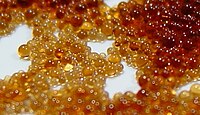
Photo from wikipedia
Polymeric ion-exchange membranes have come a long way since their invention, benefiting a wide range of processes, ranging from desalination to fuel cells. However, challenges such as alkaline stability, monovalent… Click to show full abstract
Polymeric ion-exchange membranes have come a long way since their invention, benefiting a wide range of processes, ranging from desalination to fuel cells. However, challenges such as alkaline stability, monovalent ion selectivity, cost-effectivity, and process sustainability largely persist. This work showcases alkaline stable anion-exchange membranes made by hot-pressing of a polyelectrolyte complex of poly(styrenesulfonate) (PSS) and poly(diallyldimethylammonium) (PDADMA). This completely aqueous production approach leads to especially dense (non-porous) saloplastic films with an excess of cationic groups, demonstrating good stability even at high salinities (up to 2 M NaCl). On key performance indicators for anion exchange membranes, such as water uptake (~40%), permselectivity (up to 97%), ion exchange capacity (1.01 mmol g-1), and resistance (2.3 O·cm2) the membranes show comparable values to commercial membranes. A drop in permselectivity at high salinities, however, indicates that the charge density of the membranes could be further improved. Still, what really sets these membranes apart is their natural long term (up to 60 days) stability at extreme acidic (pH 0) and alkaline conditions (pH 14) and a relevant monovalent selectivity of up to 6.3 for Cl- over SO42-. Overall this work showcases PDADMA/PSS based saloplastics as highly promising and stable anion-exchange membranes, that can be produced by a simple, scalable, and sustainable approach.
Journal Title: Journal of colloid and interface science
Year Published: 2021
Link to full text (if available)
Share on Social Media: Sign Up to like & get
recommendations!